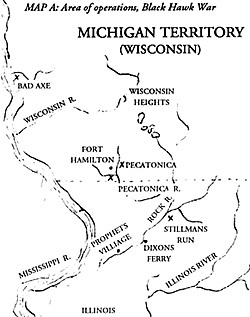 The Battle of Pecatonica was one of several small skirmishes fought during the Black Hawk War of 1832. Despite it's small size, this battle had great significance at the time. It was the first victory by the U.S. forces in this particular war, and as such, it helped to restore the spirit of the demoralized Illinois Militia who had been soundly thrashed a month earlier in the Battle of Stillman's Run.
The Battle of Pecatonica was one of several small skirmishes fought during the Black Hawk War of 1832. Despite it's small size, this battle had great significance at the time. It was the first victory by the U.S. forces in this particular war, and as such, it helped to restore the spirit of the demoralized Illinois Militia who had been soundly thrashed a month earlier in the Battle of Stillman's Run.
The Black Hawk War began in April of 1832, when a group of Sauk and Fox indians numbering 500 warriors and 1000 civilians crossed the Mississippi into Illinois. The Indians, led by Black Hawk, had been expelled from their homeland in Illinois the previous year, supposedly because they had been threatening white settlers. The truth was chat the whites had been settling on land legally controlled by the indians, and ploughing up the countryside. It seems to me that the indians had good reason to be angry.
At any rate, Black Hawk and his followers returned to Illinois in 1832. It is unlikely that they meant any harm. They had been invited by a halfSauk, half-Winnebago chief named the Prophet to join him at his village on the Rock River (modern-day Prophetstown, IL.) Considering the large number of civilians in his band, it is probable that Black Hawk's intentions were simply to re-settle at the Prophets village.
The whites didn't see it that way, however. They considered Black Hawk's return a violation of a treaty signed in 1831, which stated that he wasn't to return to Illinois. In truth, the treaty was only an excuse, as it wasn't legal. It's author, Illinois Governor John Reynolds, had no authority to make a treaty, and it had never been ratified by Congress. The real reason for white concern was the fear that the indians meant to make war on white settlers. And so the two sides, misunderstanding each other, stumbled into war.
Battle of Stillman's Run
The first battle of the war occurred on May 14th, at a place called Old Man's Creek (modern-day Stillman Valley, IL). Black Hawk, realizing that the whites were intent on his destruction, decided to surrender. He sent two braves with a white cloth to talk with the 250 Illinois militiamen led by Major Isaiah Stillman. The whites, who had set up their camp for the night and commenced to getting drunk, ignored the white flag and dragged the two indians into their camp, where they were roughly handled.
When Black Hawk heard what had happened, he fell into a rage. He tore up a flag of surrender which he had been preparing to give to the white commander, and charged off after the whites along with 50 of his warriors.
When the Illinois militiamen first spotted Black Hawk's band approaching, they headed out to meet them. Then the Indians let out a war whoop and charged, and half drunk militiamen turned tail and ran. Not back to their camp, but all the way to Dixon's Ferry (modern day Dixon, IL), 25 miles away!
So ended the fight, which became known as the Battle of Stillman's Run. The death toll was 11 whites killed, and about 3 indians killed. The militiamen who made it all the way to Dixon's Ferry told a tale of being attacked by up to a thousand indians. In truth, it had taken only 50 braves to rout Major Stillman's 250 man force.
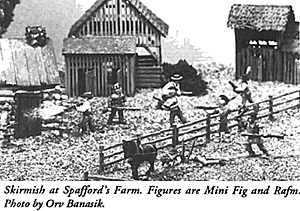 The Battle of Stillman's Run was a severe blow to the morale of the mostly militia army. In the weeks that followed, Indian raids continued on civilian settlements throughout northern Illinois and Michigan territory (Wisconsin was not yet a state), causing a general panic. Settlers began building their own forts for protection while the army tried to keep itself from failing apart.
The Battle of Stillman's Run was a severe blow to the morale of the mostly militia army. In the weeks that followed, Indian raids continued on civilian settlements throughout northern Illinois and Michigan territory (Wisconsin was not yet a state), causing a general panic. Settlers began building their own forts for protection while the army tried to keep itself from failing apart.
The battle had a morale effect on the Indians as well. Black Hawk and his band gave up the idea of surrender and sent his civilians north while he and his warriors raided settlements. Other small groups of Indians from the Winnebago, Potowatomi, and Kickapoo tribes joined in the fray.
On June 14th, one such band of Kickapoo braves struck at a group of six men working in a field at Spafford's Farm (modern day South Wayne, WI). Five of the men were killed, but one escaped to send word to nearby Fort Hamilton (modern-day Wiota, WI). When the fort's inhabitants discovered what happened, they sent for help.
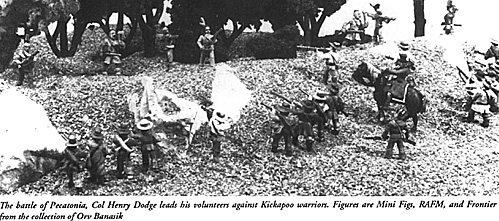 Battle of Pecatonica
Battle of Pecatonica
Assistance came in the form of Colonel Henry Dodge, commander of the Michigan Territory Volunteers. While riding toward Fort Hamilton on June 16th, he passed a settler heading die other direction. Shortly thereafter as Dodge reached the fort, shots were heard. The settler had been ambushed and killed.
Dodge quickly organized 29 volunteers from the fort and set off in a pursuit of the indians. After a chase of about five Miles, Dodge and his men cornered the eleven Kickapoo warriors in a horseshoe bend in the Pecatonica River. The indians dismounted and hid behind a natural embankment, their backs to the river. Dodge dismounted his force, leaving four to guard their rear and four more to hold the horses.
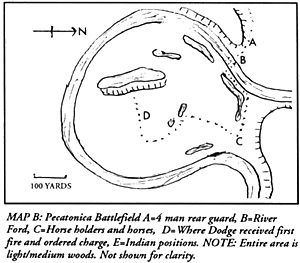 Dodge's force of 22 men advanced cautiously. The Indians fired off a volley and dropped four whites, three killed and one wounded. Dodge quickly ordered his men to charge the indians before they could reload. The Indians, seeing the whites approaching, tried to scramble up the embankment to meet them in hand to hand combat. But before the two forces met, Dodge's men fired a deadly volley at point blank range, killing nine of the Indians instantly. The other two were shot soon after as they tried to escape.
Dodge's force of 22 men advanced cautiously. The Indians fired off a volley and dropped four whites, three killed and one wounded. Dodge quickly ordered his men to charge the indians before they could reload. The Indians, seeing the whites approaching, tried to scramble up the embankment to meet them in hand to hand combat. But before the two forces met, Dodge's men fired a deadly volley at point blank range, killing nine of the Indians instantly. The other two were shot soon after as they tried to escape.
The volunteers, elated by their victory, began scalping the Indians. They were so excited that a brawl broke out between two men over the possession of a dead brave. A few hours later, Colonel William Hamilton, builder of Fort Hamilton, arrived on the scene with some Menominee Indian mercenaries. Hamilton's group was so angry at missing the fight that they vented their rage by hacking up the dead Kickapoo bodies and scattering the remains about the battlefield.
The Battle of Pecatonica was a morale booster for the whites. Once it was shown that the indians weren't invincible, the recruiting of militia increased. The civilians in the area replaced their panic with grim determination. Even so, the war continued.
As Black Hawk's band continued north, the army followed. They caught up with the indians on July 21st at a place called Wisconsin Heights (near modern-day Sauk City, WI), and battle was joined. In a brilliant example of a delay action, Black Hawks 50 or so warriors held off upwards of 800 militia while his other warriors escorted the civilians across the Wisconsin River.
Despite this magnificent victory, Black Hawk's band was on it's last leg. Pursued doggedly by the whites, the now starving, exhausted indians made a mad dash for the Mississippi River and safety.
But it was not to be. On August 2nd at a place called Bad Axe (modern-day Victory, WI), the whites again caught up with the Indians. Reinforced by a cannon armed steamboat named the 'Warrior" the army massacred the indians -- men, women and children.
So ended the Black Hawk War. In all, some 200 whites and 1400 indians had died in the four months of fighting. Black Hawk himself survived, having not been present at the Bad Axe massacre. He was later captured by Winnebago indians and turned over to the army. He spent the fall and winter of 1832 in captivity, then was taken on a tour of New England the following spring. He was finally released in the late summer of 1833, in the custody of a friendly Sauk chief named Keokuk. He died peacefully in 1838, at the age of 71. Near the end of his fife a visitor asked him about the war, to which he replied, "Rock River was a beautiful country. I loved my towns, my cornfields, and the home of my people. I fought for them."
WARGAMING THE BATTLE OF PECATONICA
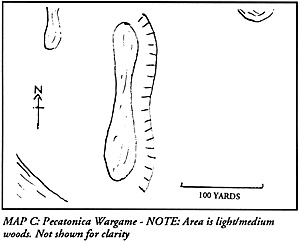 The Battle of Pecatonica is probably the easiest Black Hawk War battle to reproduce as a wargame, and makes an excellent starting place for gamers interested in the period. Here are some ideas on how to set it up as a wargame.
The Battle of Pecatonica is probably the easiest Black Hawk War battle to reproduce as a wargame, and makes an excellent starting place for gamers interested in the period. Here are some ideas on how to set it up as a wargame.
RULES:
This is a skirmish level game. just about any set of 1:1 scale skirmish rides suitable for the Horse & Musket era can be used. For myself, I use Rudy Scott Nelson's "Glory" rules. I have also recently obtained a copy of Wayne Jacob's "Napenaltowaktsche" rules, which looks like it would work as well.
FORCES
There were eleven indians present, who should be rated as average or above-average in whatever rules you use. Woodland indian figures produced by various companies for the French and Indian War would work well.
Dodge's Michigan Territory Volunteers numbered 22, including Dodge himself. This total doesn't include the four horse holders and rear guardsmen who took no part in the battle. Dodge's men should be rated as average for your rules system. Dodge himself should be a veteran level leaders.
It is likely that these men wore simple civilian clothing. If you want to portray them as such, you can use figures from the Revolutionary War and War of 1812 lines, with the odd Mexican War militia or Civil War confederate thrown in. If you can find figures from the Texas Revolution line, they would work best. just be sure that the figures you use are clean shaven. Beards had not yet come into style in the 1830's.
TERRAIN
The accompanying may (Map B) is based on One drawn shortly after the war, as well as my own observations from a recent visit to the battle site.
The entire area should be considered light to medium woods, The river can only be crossed at the ford. The Embankment that the indians hid behind was quite steep, and should require a full turn to climb from the low side. The pools of stagnant water scattered about the map are shallow. Movement through them should be treated as crossing a ford.
You probably won't be able to fit the entire battlefield on your table, and you don't need to. Map C shows the portion you need to represent, scaled for a 6' by 4' table at 1 inch equals 5 yards. If you use this map, assume that the south and west table edges are blocked by the river. The indians will retreat to the north, the whites to the northeast. The indians; start the game positioned behind the embankment, and the whites enter the table from the east on turn 1. As an alternative, you can let the indians set up anywhere on the board, hidden.
For victory conditions, I suggest a point system, Give the indians 2 points for each white that retreats off the board, and five for each killed, with Col. Dodge being worth double. Give the whites 7 points for each Indian killed, and 1 point for each indian that routs or disengages. The Black Hawk War has always fascinated me, largely I suppose because it tool place in my own 'back yard', so to speak. Also, I have always had a fascination with the American Indian Wars. I hope you enjoy refighting this battle, and perhaps learn a little something about this peculiar war. If so, then this article has served it's purpose.
SOURCES
Eby, Cecil, That Disgraceful Affair: The Black Hawk War, New York, NYW.W.Norton & Company, Inc., 1973
Efflandt, Llyod H., The Black Hawk War, Why? Rock Island, II,- Rock Island Historical Society, 1986
Stark, William F., Along the Black Hawk Train, Sheboygan, WE Zimmerman Press, 1984
Back to Table of Contents -- Courier #60
To Courier List of Issues
To MagWeb Master Magazine List
© Copyright 1993 by The Courier Publishing Company.
This article appears in MagWeb (Magazine Web) on the Internet World Wide Web.
Other military history articles and gaming articles are available at http://www.magweb.com